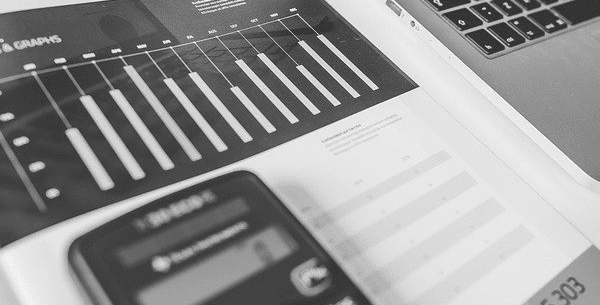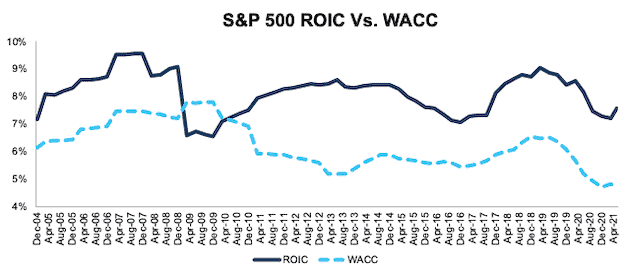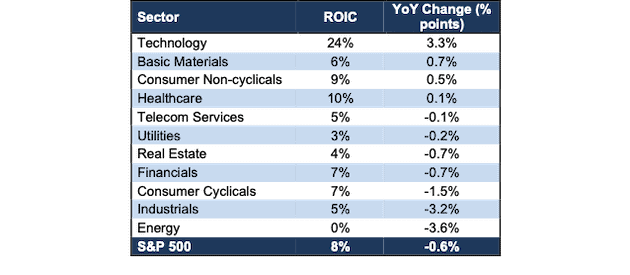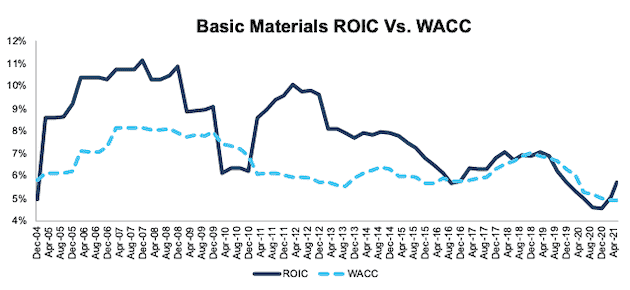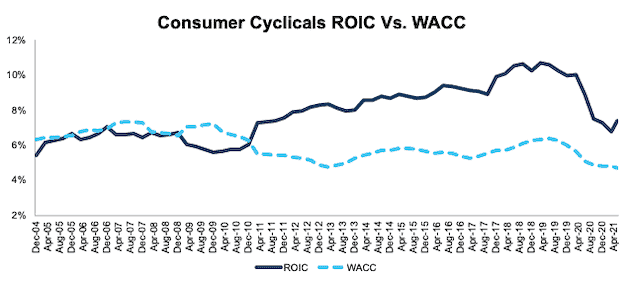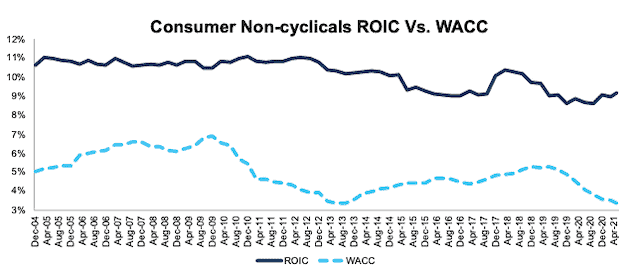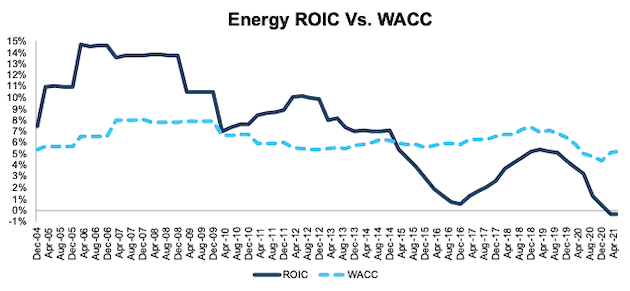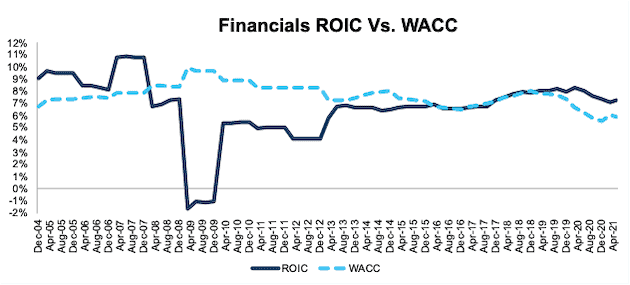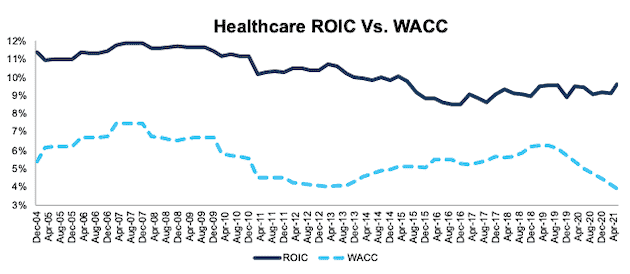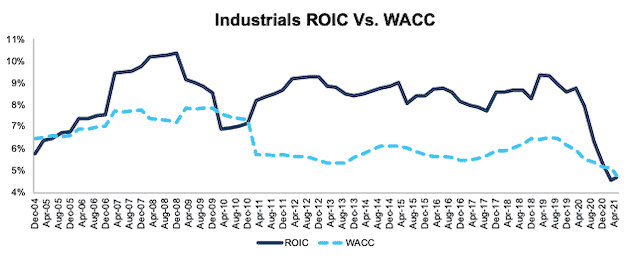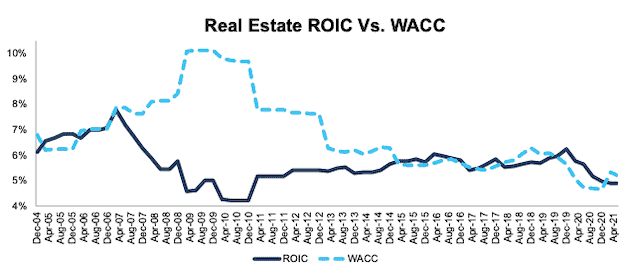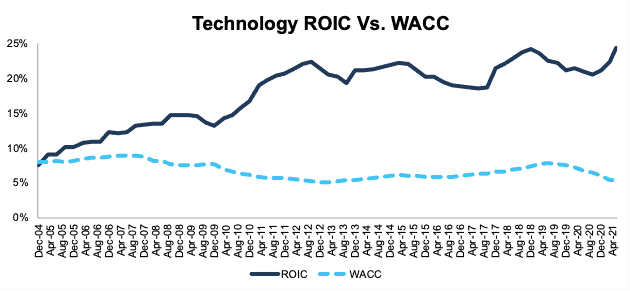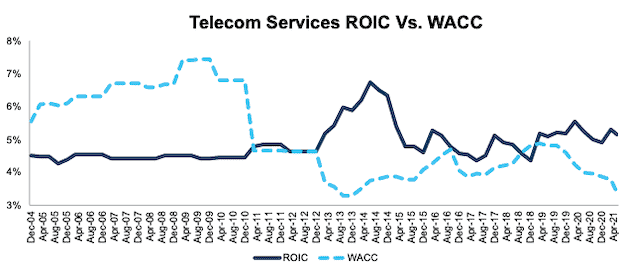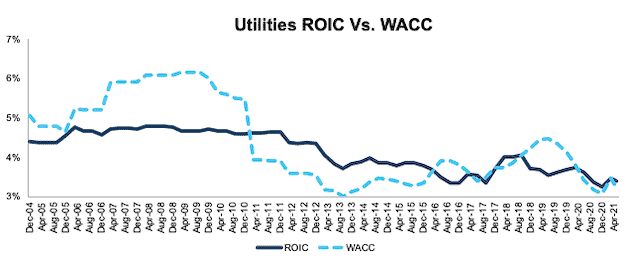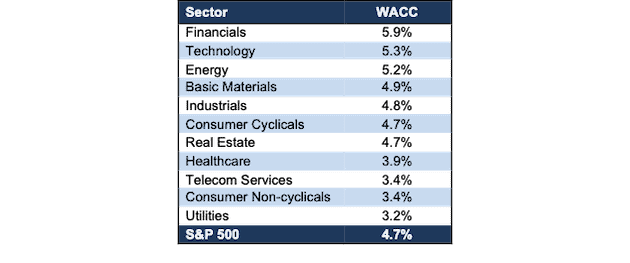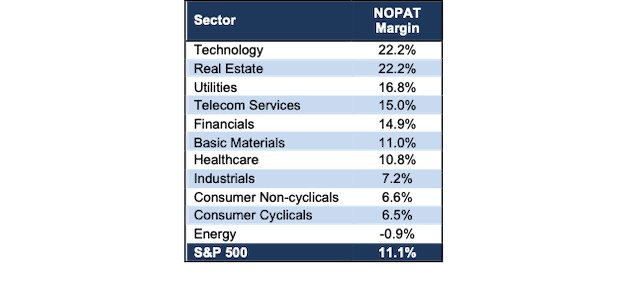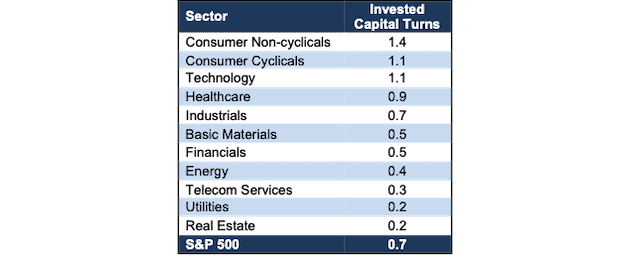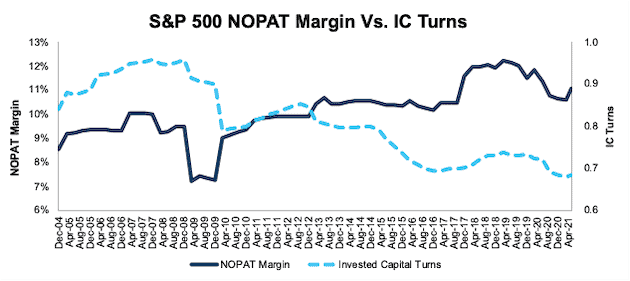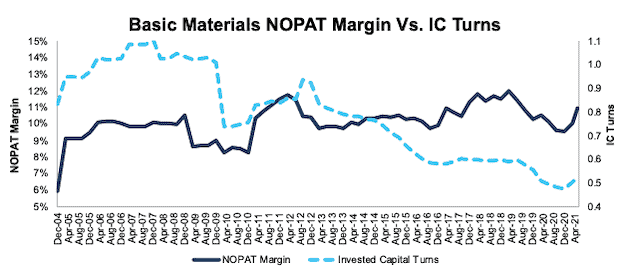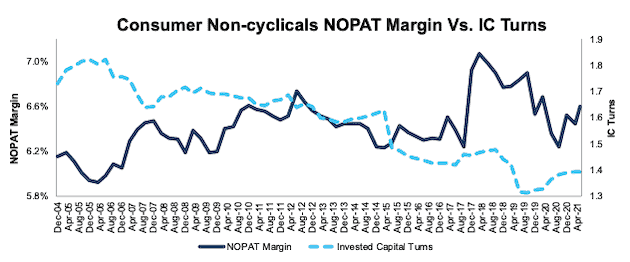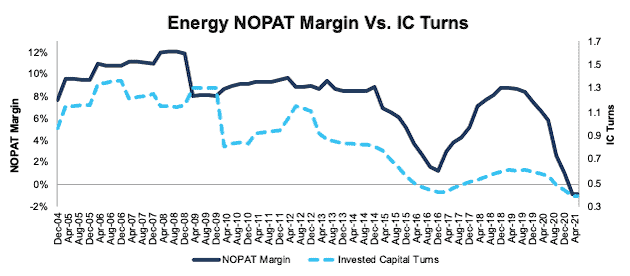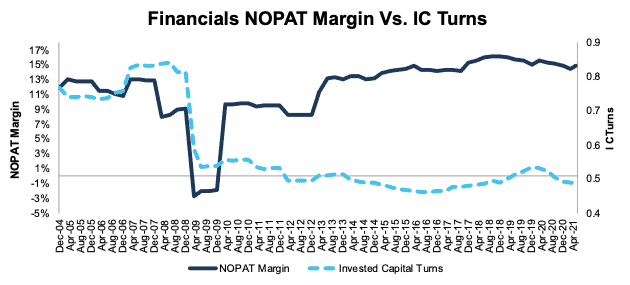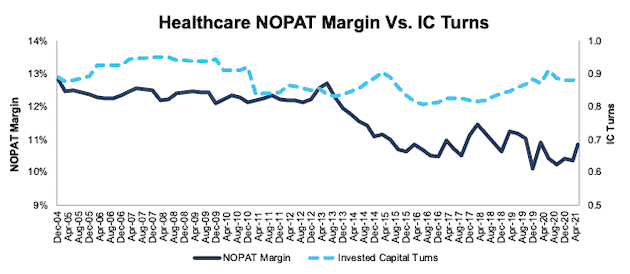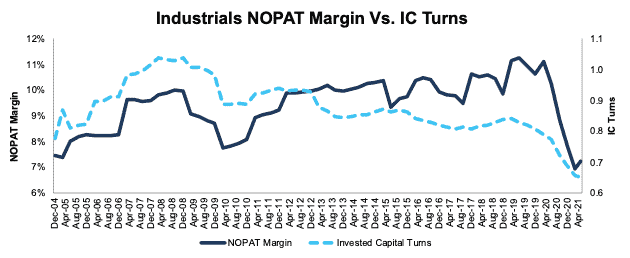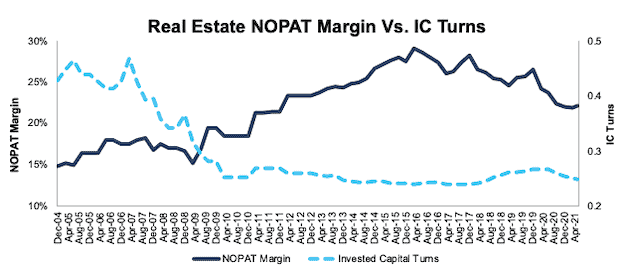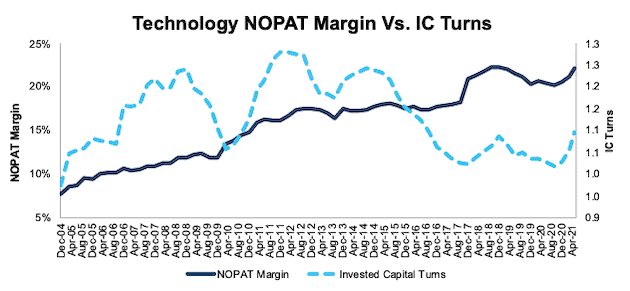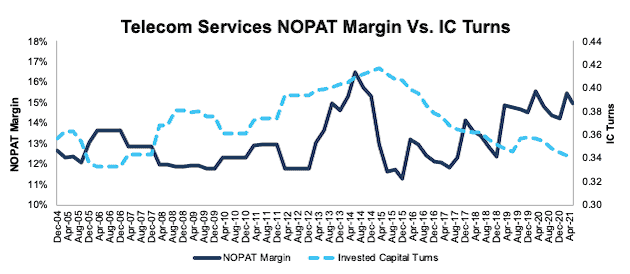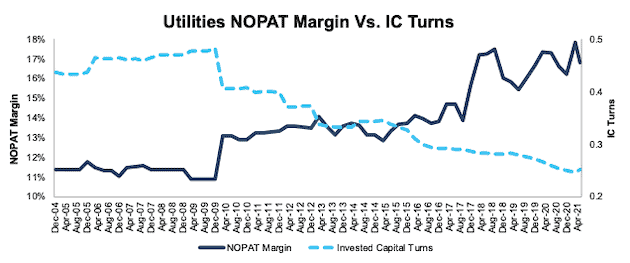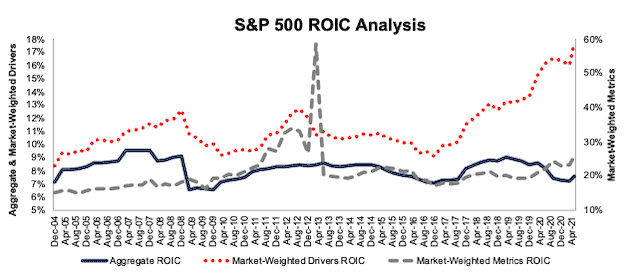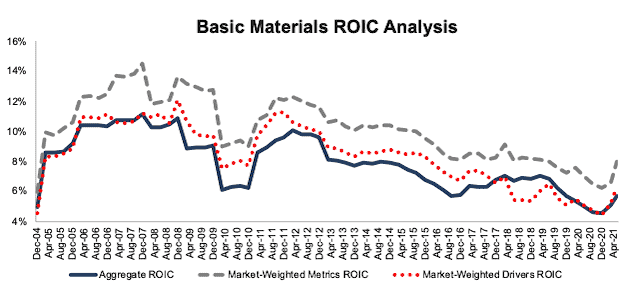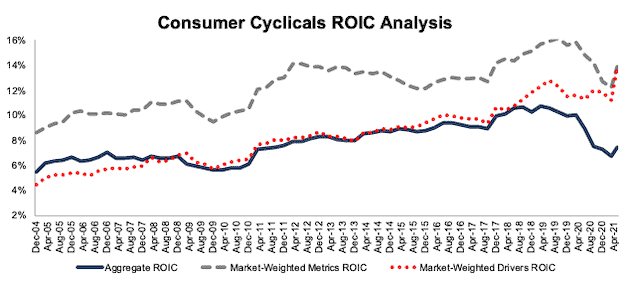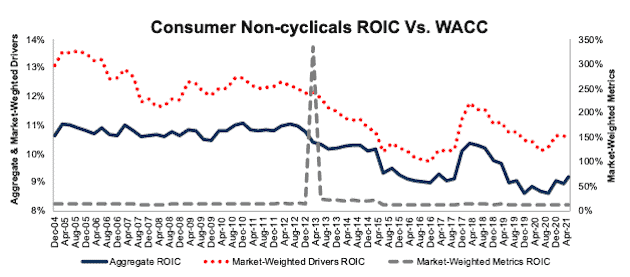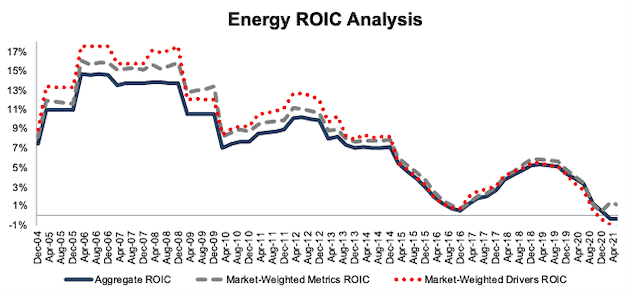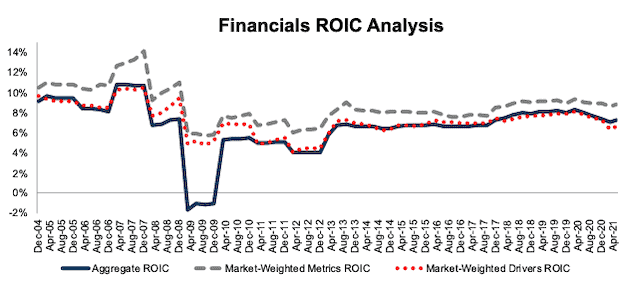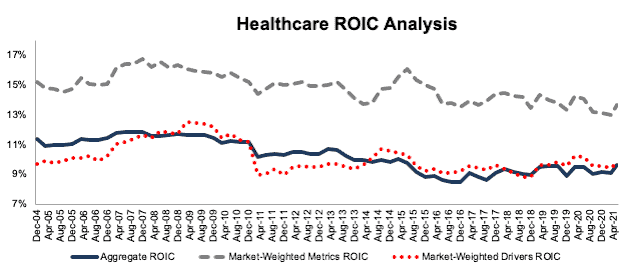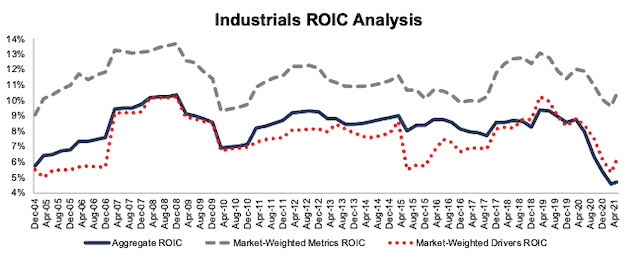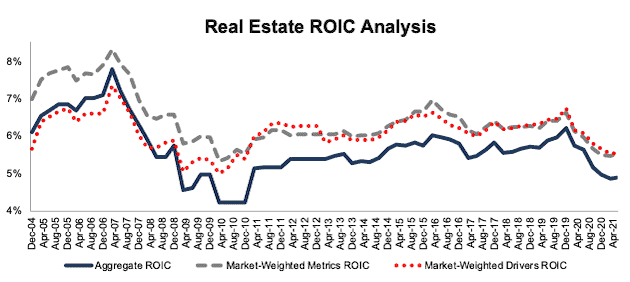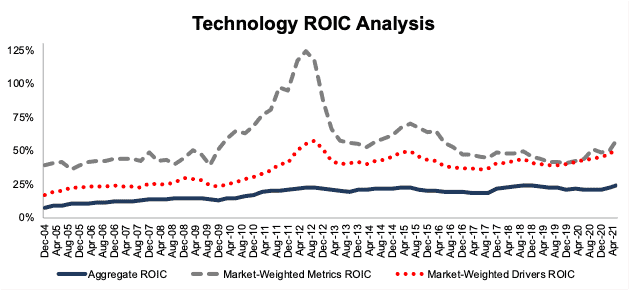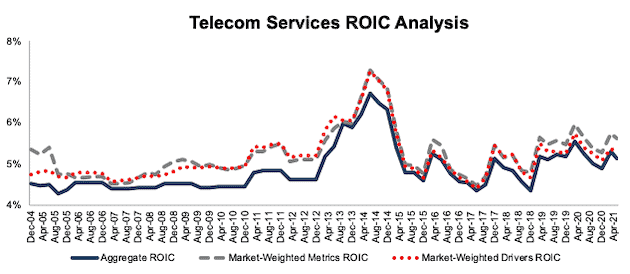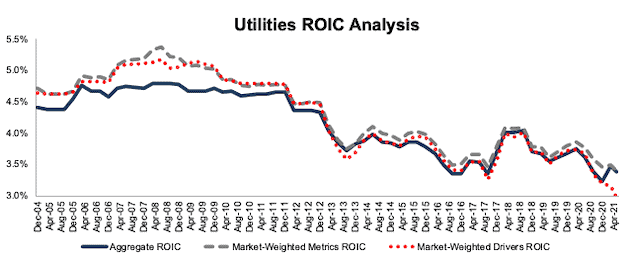The Technology, Basic Materials, Consumer Non-cyclicals, and Healthcare sectors saw an improvement in ROIC year-over-year (YoY) based on 1Q21 financial data. Last quarter, just two sectors, Technology & Consumer Non-cyclicals, saw a YoY improvement.
This report analyzes the drivers[1] of economic earnings [return on invested capital (ROIC), NOPAT margin, invested capital turns, and weighted average cost of capital (WACC)] for the S&P 500 and each of its sectors. In this report, our research is based on the latest audited financial data, which is the calendar 1Q21 10-Q for most companies. Price data is as of 5/19/21.
For reference, we analyze the Core Earnings for each S&P 500 sector in S&P 500 & Sectors: Core Earnings Vs. GAAP Net Income Through 1Q21.
These reports leverage more reliable fundamental data[2] that enables investors to overcome flaws with legacy fundamental datasets. Investors armed with our research enjoy a differentiated and more informed view of the fundamentals and valuations of companies and sectors.
S&P 500 ROIC Rebounds in 1Q21
After falling significantly in 2020, the S&P 500’s ROIC improved from 7.2% at the end of 2020 to 7.6% as of 5/19/21, the earliest date 1Q21 quarterly data was provided by all S&P 500 companies. See Figure 1.
Figure 1: ROIC and WACC for the S&P 500 From December 2004 – 5/19/21[3]
Sources: New Constructs, LLC and company filings.
The May 19, 2021 measurement period uses price data as of that date and incorporates the financial data from 1Q21 10-Qs, as this is the earliest date for which all the 1Q21 10-Qs for the S&P 500 constituents were available.
Ranking the S&P 500 Sectors by Change in ROIC
Figure 2 ranks all 11 S&P 500 sectors by the change in ROIC from the end of 1Q20 to 1Q21.
Figure 2: ROIC for All S&P 500 Sectors
Sources: New Constructs, LLC and company filings.
Financial data from 1Q21 10-Qs.
The Technology sector performed best over the past year, with its ROIC rising over 300 basis points. This trend is not surprising given that the global shutdowns brought on by COVID-19 accelerated the enterprise and individual shift to cloud and other software solutions.
On the flip side, the Energy and Industrials sectors, two highly capital intensive industries with significant cuts to profitability during COVID-19, have the largest drop in ROIC YoY.
Overall, the Technology sector earns the highest ROIC of all sectors, by far, and the Energy sector earns the lowest ROIC. These trends in the Technology and Energy sector mirror the changes in Core Earnings we analyze in S&P 500 & Sectors: Core Earnings Vs. GAAP Net Income Through 1Q21.
Details on each of the S&P 500 Sectors
Figures 3-13 compare the ROIC and WACC trends for every sector since the end of 2004. Appendix I presents the current WACC for each sector.
Appendix II presents the drivers of ROIC: NOPAT margin and invested capital turns for each sector.
Appendix III presents additional ROIC analysis based on different weighting methodologies to adjust for the impact of a firm’s size on its sector and the S&P 500.
Basic Materials
Figure 3 shows the ROIC for the Basic Materials sector has been in a long-term decline since ~2011 but improved 116 basis points since late 2020. The Basic Materials sector NOPAT margin improved from 10.1% in 1Q20 to 11.0% in 1Q21, and invested capital turns improved from 0.49 to 0.52 over the same time.
Figure 3: Basic Materials ROIC vs. WACC: December 2004 – 5/19/21
Sources: New Constructs, LLC and company filings.
The May 19, 2021 measurement period uses price data as of that date and incorporates the financial data from 1Q21 10-Qs, as this is the earliest date for which all the 1Q21 10-Qs for the S&P 500 constituents were available.
Consumer Cyclicals
Figure 4 shows the ROIC for the Consumer Cyclicals sector was hit hard by the COVID-19 pandemic but began to rebound in 1Q21, when it improved to 7.4%, which is up from 6.7% at the end of 2020. The Consumer Cyclicals sector NOPAT margin improved from 6.0% at the end of 2020 to 6.5% in 1Q21, and invested capital turns remained flat at 1.1 over the same time.
Figure 4: Consumer Cyclicals ROIC vs. WACC: December 2004 – 5/19/21
Sources: New Constructs, LLC and company filings.
The May 19, 2021 measurement period uses price data as of that date and incorporates the financial data from 1Q21 10-Qs, as this is the earliest date for which all the 1Q21 10-Qs for the S&P 500 constituents were available.
Consumer Non-cyclicals
Figure 5 shows ROIC for the Consumer Non-Cyclicals sector trended higher in recent quarters and, at 9.2% in 1Q21, is at its highest level since the end of 2018. The Consumer Non-cyclicals sector NOPAT margin improved from 6.4% in 1Q20 to 6.6% in 1Q21, and invested capital turns rose from 1.36 to 1.39 over the same time.
Figure 5: Consumer Non-cyclicals ROIC vs. WACC: December 2004 – 5/19/21
Sources: New Constructs, LLC and company filings.
The May 19, 2021 measurement period uses price data as of that date and incorporates the financial data from 1Q21 10-Qs, as this is the earliest date for which all the 1Q21 10-Qs for the S&P 500 constituents were available.
Energy
Figure 6 shows the ROIC for the Energy sector was hit hardest during the COVID-19 pandemic. The deteriorating ROIC wiped out all the improvement achieved from 2016 to mid-2019. The decline in ROIC from 3.2% in 1Q20 to -0.4% in 1Q21 is driven by NOPAT margin falling from 5.8% in 1Q20 to -0.9% in 1Q21, and invested capital turns falling from 0.56 to 0.39 over the same time.
Figure 6: Energy ROIC vs. WACC: December 2004 – 5/19/21
Sources: New Constructs, LLC and company filings.
The May 19, 2021 measurement period uses price data as of that date and incorporates the financial data from 1Q21 10-Qs, as this is the earliest date for which all the 1Q21 10-Qs for the S&P 500 constituents were available.
Financials
Figure 7 shows ROIC for the Financials sector declined 74 basis points YoY in 1Q21 but remains well above the lows of the Financial Crisis. Given the stability in ROIC since 2013, one could argue regulators were successful in turning large Financial firms into “boring”, more stable businesses. The Financials sector NOPAT margin fell from 15.3% in 1Q20 to 14.9% in 1Q21, and invested capital turns fell from 0.52 to 0.49 over the same time.
Figure 7: Financials ROIC vs. WACC: December 2004 – 5/19/21
Sources: New Constructs, LLC and company filings.
The May 19, 2021 measurement period uses price data as of that date and incorporates the financial data from 1Q21 10-Qs, as this is the earliest date for which all the 1Q21 10-Qs for the S&P 500 constituents were available.
Healthcare
Figure 8 shows the Healthcare sector ROIC improved 14 basis points YoY in 1Q21 and has remained relatively stable since the end of 2016. The improvement in ROIC is driven by the Healthcare sector NOPAT margin rising from 10.4% in 1Q20 to 10.8% in 1Q21. Invested capital turns declined from 0.91 to 0.89 over the same time.
Figure 8: Healthcare ROIC vs. WACC: December 2004 – 5/19/21
Sources: New Constructs, LLC and company filings.
The May 19, 2021 measurement period uses price data as of that date and incorporates the financial data from 1Q21 10-Qs, as this is the earliest date for which all the 1Q21 10-Qs for the S&P 500 constituents were available.
Industrials
Figure 9 shows ROIC for the Industrials sector was the second hardest hit over the past year and fell 323 basis points YoY as the sector bore much of the brunt of the global shutdowns. The Industrials sector NOPAT margin fell from 10.3% in 1Q20 to 7.2% in 1Q21, and invested capital turns fell from 0.77 to 0.65 over the same time.
Figure 9: Industrials ROIC vs. WACC: December 2004 – 5/19/21
Sources: New Constructs, LLC and company filings.
The May 19, 2021 measurement period uses price data as of that date and incorporates the financial data from 1Q21 10-Qs, as this is the earliest date for which all the 1Q21 10-Qs for the S&P 500 constituents were available.
Real Estate
Figure 10 shows the Real Estate sector ROIC has fallen significantly since 2019. Longer term, the ROIC for this sector has yet to regain the highs achieved prior to the Financial Crisis. The Real Estate sector NOPAT margin fell from 23.7% in 1Q20 to 22.2% in 1Q21, and invested capital turns fell from 0.22 to 0.20 over the same time.
Figure 10: Real Estate ROIC vs. WACC: December 2004 – 5/19/21
Sources: New Constructs, LLC and company filings.
The May 19, 2021 measurement period uses price data as of that date and incorporates the financial data from 1Q21 10-Qs, as this is the earliest date for which all the 1Q21 10-Qs for the S&P 500 constituents were available.
Technology
Figure 11 shows the Technology sector ROIC improved from 21.0% in 1Q20 to 24.3% in 1Q21. This sector has the highest ROIC by a wide margin. The Technology sector NOPAT margin improved from 20.5% in 1Q21 to 22.2% in 1Q21, and invested capital turns improved from 1.03 to 1.10 over the same time.
Figure 11: Technology ROIC vs. WACC: December 2004 – 5/19/21
Sources: New Constructs, LLC and company filings.
The May 19, 2021 measurement period uses price data as of that date and incorporates the financial data from 1Q21 10-Qs, as this is the earliest date for which all the 1Q21 10-Qs for the S&P 500 constituents were available.
Telecom Services
Figure 12 shows the ROIC for the Telecom Services sector fell 11 basis points YoY in 1Q21 and remains well below its peak in mid-2014. The Telecom Services sector NOPAT margin improved from 14.8% in 1Q20 to 15.0% in 1Q21, and invested capital turns fell from 0.35 to 0.34 over the same time.
Figure 12: Telecom Services ROIC vs. WACC: December 2004 – 5/19/21
Sources: New Constructs, LLC and company filings.
The May 19, 2021 measurement period uses price data as of that date and incorporates the financial data from 1Q21 10-Qs, as this is the earliest date for which all the 1Q21 10-Qs for the S&P 500 constituents were available.
Utilities
Figure 13 shows the ROIC for the Utilities sector fell 23 basis points YoY in 1Q21 and remains in a long-term downtrend. The Utilities sector NOPAT margin fell from 17.3% in 1Q20 to 16.8% in 1Q21, and invested capital turns fell from 0.21 to 0.20 over the same time.
Figure 13: Utilities ROIC vs. WACC: December 2004 – 5/19/21
Sources: New Constructs, LLC and company filings.
The May 19, 2021 measurement period uses price data as of that date and incorporates the financial data from 1Q21 10-Qs, as this is the earliest date for which all the 1Q21 10-Qs for the S&P 500 constituents were available.
This article originally published on May 25, 2021.
Disclosure: David Trainer, Kyle Guske II, Alex Sword, and Matt Shuler receive no compensation to write about any specific stock, style, or theme.
Follow us on Twitter, Facebook, LinkedIn, and StockTwits for real-time alerts on all our research.
Appendix I: WACC for Each Sector and S&P 500
This appendix shows the WACC for the S&P 500 and each sector in 1Q21, based on prices as of 5/19/21 and financial data from 1Q21 10-Qs.
We derive the sector and S&P 500 WACCs by solving for WACC in the economic earnings formula:
(ROIC-WACC)*Average Invested Capital = Economic Earnings
translates to
WACC = ROIC - Economic Earnings/Average Invested Capital
We calculate Economic Earnings, NOPAT and Invested Capital according to the Aggregate methodology described in Appendix III.
Figure 14: WACC by Sector – as of 5/19/21
Sources: New Constructs, LLC and company filings.
Prices as of 5/19/21, financial data from 1Q21 10-Qs.
Appendix II: NOPAT Margin and Invested Capital Turns Since 2004
This appendix shows the two key drivers (DuPont model) of ROIC – NOPAT margin and invested capital turns – for each sector going back to December 2004. We sum the individual S&P 500 constituent values for revenue, NOPAT, and invested capital to calculate these metrics. We call this approach the “Aggregate” methodology. More methodology details in Appendix III.
Figure 15 ranks all 11 sectors by NOPAT margin based on financial data from 1Q21 10-Qs.
Figure 15: NOPAT Margin by Sector – Financial Data from 1Q21 10-Qs
Sources: New Constructs, LLC and company filings.
Financial data from 1Q21 10-Qs.
Figure 16 ranks all 11 sectors by invested capital turns based on financial data from 1Q21 10-Qs.
Figure 16: Invested Capital Turns by Sector – Financial Data from 1Q21 10-Qs
Sources: New Constructs, LLC and company filings.
Financial data from 1Q21 10-Qs
These two tables show how rare it is for a sector to have both high margins and capital turns. Real Estate, the second-highest margin sector, has the worst invested capital turns. Consumer Non-cyclicals, the sector with the highest invested capital turns has the third lowest margin. The Technology sector has both high margins and invested capital turns, which is why that sector leads the market in ROIC by a wide margin.
Figures 17-28 compare the NOPAT margin and invested capital turns trends for the S&P 500 and every sector since 2004.
Figure 17: S&P 500 NOPAT Margin and IC Turns: December 2004 – 5/19/21
Sources: New Constructs, LLC and company filings.
The May 19, 2021 measurement period uses price data as of that date and incorporates the financial data from 1Q21 10-Qs, as this is the earliest date for which all the 1Q21 10-Qs for the S&P 500 constituents were available.
Figure 18: Basic Materials NOPAT Margin and IC Turns: December 2004 – 5/19/21
Sources: New Constructs, LLC and company filings.
The May 19, 2021 measurement period uses price data as of that date and incorporates the financial data from 1Q21 10-Qs, as this is the earliest date for which all the 1Q21 10-Qs for the S&P 500 constituents were available.
Figure 19: Consumer Cyclicals NOPAT Margin and IC Turns: December 2004 – 5/19/21
Sources: New Constructs, LLC and company filings.
The May 19, 2021 measurement period uses price data as of that date and incorporates the financial data from 1Q21 10-Qs, as this is the earliest date for which all the 1Q21 10-Qs for the S&P 500 constituents were available.
Figure 20: Consumer Non-Cyclicals NOPAT Margin and IC Turns: December 2004 – 5/19/21
Sources: New Constructs, LLC and company filings.
The May 19, 2021 measurement period uses price data as of that date and incorporates the financial data from 1Q21 10-Qs, as this is the earliest date for which all the 1Q21 10-Qs for the S&P 500 constituents were available.
Figure 21: Energy NOPAT Margin and IC Turns: December 2004 – 5/19/21
Sources: New Constructs, LLC and company filings.
The May 19, 2021 measurement period uses price data as of that date and incorporates the financial data from 1Q21 10-Qs, as this is the earliest date for which all the 1Q21 10-Qs for the S&P 500 constituents were available.
Figure 22: Financials NOPAT Margin and IC Turns: December 2004 – 5/19/21
Sources: New Constructs, LLC and company filings.
The May 19, 2021 measurement period uses price data as of that date and incorporates the financial data from 1Q21 10-Qs, as this is the earliest date for which all the 1Q21 10-Qs for the S&P 500 constituents were available.
Figure 23: Healthcare NOPAT Margin and IC Turns: December 2004 – 5/19/21
Sources: New Constructs, LLC and company filings.
The May 19, 2021 measurement period uses price data as of that date and incorporates the financial data from 1Q21 10-Qs, as this is the earliest date for which all the 1Q21 10-Qs for the S&P 500 constituents were available.
Figure 24: Industrials NOPAT Margin vs. IC Turns: December 2004 – 5/19/21
Sources: New Constructs, LLC and company filings.
The May 19, 2021 measurement period uses price data as of that date and incorporates the financial data from 1Q21 10-Qs, as this is the earliest date for which all the 1Q21 10-Qs for the S&P 500 constituents were available.
Figure 25: Real Estate NOPAT Margin Vs. IC Turns: December 2004 – 5/19/21
Sources: New Constructs, LLC and company filings.
The May 19, 2021 measurement period uses price data as of that date and incorporates the financial data from 1Q21 10-Qs, as this is the earliest date for which all the 1Q21 10-Qs for the S&P 500 constituents were available.
Figure 26: Technology NOPAT Margin Vs. IC Turns: December 2004 – 5/19/21
Sources: New Constructs, LLC and company filings.
The May 19, 2021 measurement period uses price data as of that date and incorporates the financial data from 1Q21 10-Qs, as this is the earliest date for which all the 1Q21 10-Qs for the S&P 500 constituents were available.
Figure 27: Telecom Services NOPAT Margin Vs. IC Turns: December 2004 – 5/19/21
Sources: New Constructs, LLC and company filings.
The May 19, 2021 measurement period uses price data as of that date and incorporates the financial data from 1Q21 10-Qs, as this is the earliest date for which all the 1Q21 10-Qs for the S&P 500 constituents were available.
Figure 28: Utilities NOPAT Margin vs. IC Turns: December 2004 – 5/19/21
Sources: New Constructs, LLC and company filings.
The May 19, 2021 measurement period uses price data as of that date and incorporates the financial data from 1Q21 10-Qs, as this is the earliest date for which all the 1Q21 10-Qs for the S&P 500 constituents were available.
Appendix III: Analyzing ROIC with Different Weighting Methodologies
We derive the metrics above by summing the individual S&P 500 constituent values for revenue, NOPAT, and invested capital to calculate the metrics presented. We call this approach the “Aggregate” methodology.
The Aggregate methodology provides a straightforward look at the entire sector, regardless of market cap or index weighting and matches how S&P Global (SPGI) calculates metrics for the S&P 500.
For additional perspective, we compare the Aggregate method for ROIC with two other market-weighted methodologies:
- Market-weighted metrics – calculated by market-cap-weighting the ROIC for the individual companies relative to their sector or the overall S&P 500 in each period. Details:
- Company weight equals the company’s market cap divided by the market cap of the S&P 500/its sector
- We multiply each company’s ROIC by its weight
- S&P 500/Sector ROIC equals the sum of the weighted ROICs for all the companies in the S&P 500/each sector
- Market-weighted drivers – calculated by market-cap-weighting the NOPAT and invested capital for the individual companies in each sector in each period. Details:
- Company weight equals the company’s market cap divided by the market cap of the S&P 500/its sector
- We multiply each company’s NOPAT and invested capital by its weight
- We sum the weighted NOPAT and invested capital for each company in the S&P 500/each sector to determine each sector’s weighted NOPAT and weighted invested capital
- S&P 500/Sector ROIC equals weighted sector NOPAT divided by weighted sector invested capital
Each methodology has its pros and cons, as outlined below:
Aggregate method
Pros:
- A straightforward look at the entire S&P 500/sector, regardless of company size or weighting in any indices.
- Matches how S&P Global calculates metrics for the S&P 500.
Cons:
- Vulnerable to impact of by companies entering/exiting the group of companies, which could unduly affect aggregate values despite the level of change from companies that remain in the group.
Market-weighted metrics method
Pros:
- Accounts for a firm’s size relative to the overall S&P 500/sector and weights its metrics accordingly.
Cons:
- Vulnerable to outsized impact of one or a few companies, as shown below in the Consumer Non-cyclicals sector. This outsized impact tends to occur only for ratios where unusually small denominator values can create extremely high or low results.
Market-weighted drivers method
Pros:
- Accounts for a firm’s size relative to the overall S&P 500/sector and weights its NOPAT and invested capital accordingly.
- Mitigates potential outsized impact of one or a few companies by aggregating values that drive the ratio before calculating the ratio.
Cons:
- Can minimize the impact of period-over-period changes in smaller companies, as their impact on the overall sector NOPAT and invested capital is smaller.
Figures 29-40 compare these three methods for calculating S&P 500 and sector ROICs.
In Figure 29, we chart the market-weighted metrics version of ROIC on its own axis to highlight the differences in the aggregate and market-weighted drivers versions of ROIC.
Note the impact on the market-weighted metrics version of ROIC for the entire S&P 500 from Lorillard (LO) in 2013, when the firm’s ROIC was more than 36,000%.
Figure 29: S&P 500 ROIC Methodologies Compared: December 2004 – 5/19/21
Sources: New Constructs, LLC and company filings.
The May 19, 2021 measurement period uses price data as of that date and incorporates the financial data from 1Q21 10-Qs, as this is the earliest date for which all the 1Q21 10-Qs for the S&P 500 constituents were available.
Figure 30: Basic Materials ROIC Methodologies Compared: December 2004 – 5/19/21
Sources: New Constructs, LLC and company filings.
The May 19, 2021 measurement period uses price data as of that date and incorporates the financial data from 1Q21 10-Qs, as this is the earliest date for which all the 1Q21 10-Qs for the S&P 500 constituents were available.
Figure 31: Consumer Cyclicals ROIC Methodologies Compared: December 2004 – 5/19/21
Sources: New Constructs, LLC and company filings.
The May 19, 2021 measurement period uses price data as of that date and incorporates the financial data from 1Q21 10-Qs, as this is the earliest date for which all the 1Q21 10-Qs for the S&P 500 constituents were available.
Note the impact on the market-weighted metrics version of ROIC for the Consumer Non-cyclicals sector from Lorillard (LO) in 2013, when the firm’s ROIC was more than 36,000%.
This outlier caused the Consumer Non-cyclicals sector’s ROIC to increase from 15% to 334% in just one period, before falling to 24% one period later.
Figure 32: Consumer Non-cyclicals ROIC Methodologies Compared: December 2004 – 5/19/21
Sources: New Constructs, LLC and company filings.
The May 19, 2021 measurement period uses price data as of that date and incorporates the financial data from 1Q21 10-Qs, as this is the earliest date for which all the 1Q21 10-Qs for the S&P 500 constituents were available.
Figure 33: Energy ROIC Methodologies Compared: December 2004 – 5/19/21
Sources: New Constructs, LLC and company filings.
The May 19, 2021 measurement period uses price data as of that date and incorporates the financial data from 1Q21 10-Qs, as this is the earliest date for which all the 1Q21 10-Qs for the S&P 500 constituents were available.
Figure 34: Financials ROIC Methodologies Compared: December 2004 – 5/19/21
Sources: New Constructs, LLC and company filings.
The May 19, 2021 measurement period uses price data as of that date and incorporates the financial data from 1Q21 10-Qs, as this is the earliest date for which all the 1Q21 10-Qs for the S&P 500 constituents were available.
Figure 35: Healthcare ROIC Methodologies Compared: December 2004 – 5/19/21
Sources: New Constructs, LLC and company filings.
The May 19, 2021 measurement period uses price data as of that date and incorporates the financial data from 1Q21 10-Qs, as this is the earliest date for which all the 1Q21 10-Qs for the S&P 500 constituents were available.
Figure 36: Industrials ROIC Methodologies Compared: December 2004 – 5/19/21
Sources: New Constructs, LLC and company filings.
The May 19, 2021 measurement period uses price data as of that date and incorporates the financial data from 1Q21 10-Qs, as this is the earliest date for which all the 1Q21 10-Qs for the S&P 500 constituents were available.
Figure 37: Real Estate ROIC Methodologies Compared: December 2004 – 5/19/21
Sources: New Constructs, LLC and company filings.
The May 19, 2021 measurement period uses price data as of that date and incorporates the financial data from 1Q21 10-Qs, as this is the earliest date for which all the 1Q21 10-Qs for the S&P 500 constituents were available.
Figure 38: Technology ROIC Methodologies Compared: December 2004 – 5/19/21
Sources: New Constructs, LLC and company filings.
The May 19, 2021 measurement period uses price data as of that date and incorporates the financial data from 1Q21 10-Qs, as this is the earliest date for which all the 1Q21 10-Qs for the S&P 500 constituents were available.
Figure 39: Telecom Services ROIC Methodologies Compared: December 2004 – 5/19/21
Sources: New Constructs, LLC and company filings.
The May 19, 2021 measurement period uses price data as of that date and incorporates the financial data from 1Q21 10-Qs, as this is the earliest date for which all the 1Q21 10-Qs for the S&P 500 constituents were available.
Figure 40: Utilities ROIC Methodologies Compared: December 2004 – 5/19/21
Sources: New Constructs, LLC and company filings.
The May 19, 2021 measurement period uses price data as of that date and incorporates the financial data from 1Q21 10-Qs, as this is the earliest date for which all the 1Q21 10-Qs for the S&P 500 constituents were available.
[1] We calculate these metrics based on SPGI’s methodology, which sums the individual S&P 500 constituent values for NOPAT and invested capital before using them to calculate the metrics. We call this the “Aggregate” methodology. Get more details in Appendix III. See Appendix I for details on how we calculate WACC for the S&P 500 and each of its sectors.
[2] For 3rd-party reviews, including The Journal of Financial Economics, on our more reliable fundamental data, historically and prospectively, across all stocks, click here and here.
[3] We use stock prices from 5/19/21 because that is the date when all the 1Q21 10-Qs for the S&P 500 constituents were available.
